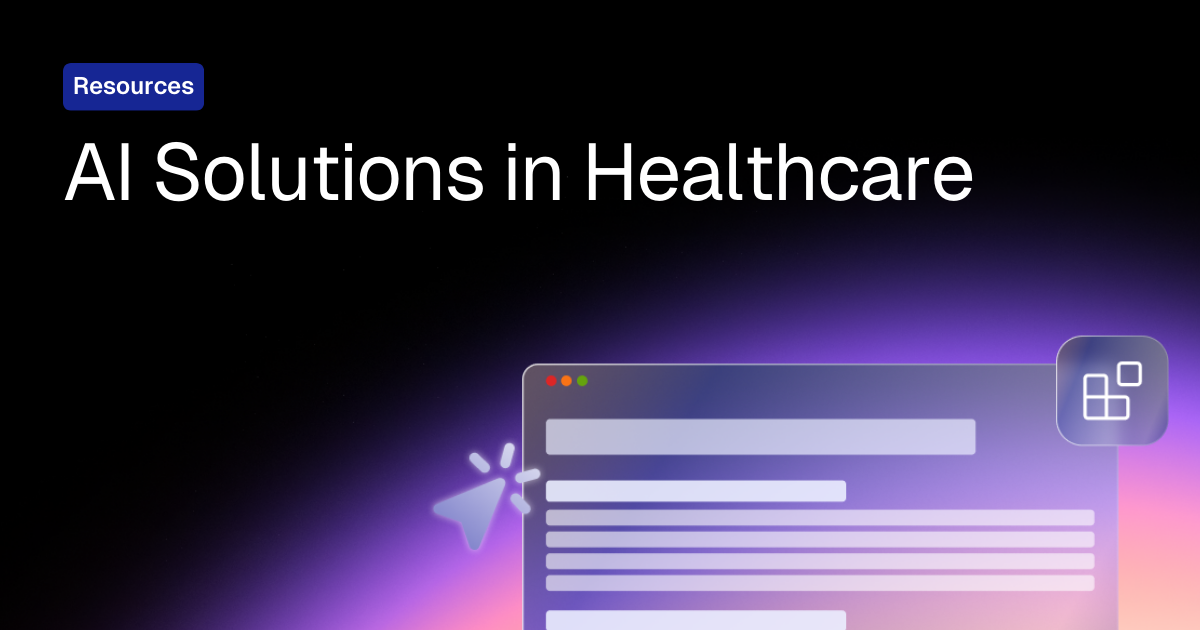AI Medical Scribes: Everything You Need to Know

What is an AI Medical Scribe?
An AI medical scribe is AI-powered software that helps thoroughly capture clinician-patient conversations and structure notes accordingly. It uses speech-to-text technology with artificial intelligence (AI) to automate parts of the documentation process. Ultimately, AI medical scribes aim to support clinicians in reducing note-taking time and maximizing workplace efficiency.
Administrative burden and cognitive load are two major challenges clinicians face in day-to-day practice. With an AI medical scribe, clinicians can easily dictate, transcribe, and transform their notes into different clinical documentation.
In this article, we will tackle how AI medical scribes work, why they are important, and the key features to consider when looking for one.

Why are AI Medical Scribes Becoming a Necessity in the Healthcare Industry?
AI medical scribes rose to popularity because of the excessive paperwork volume and the consequent overwhelm that clinicians face. To prevent burnout among healthcare professionals, the need for AI medical scribes has emerged.
In clinical practice, documentation is a crucial step in attending to the medical needs of a patient. Given the multiple competing priorities of clinicians, attending to daily documentation can be a significant burden that’s difficult to manage.
AI-enabled medical scribes assist clinicians in the documentation process by saving time and alleviating cognitive load. These scribes were designed to complement electronic health records (EHR), which meticulously record patient medical histories.
How Does an AI Medical Scribe Work?
Generally, ambient AI scribes in medical practice use large language models (LLMs) and machine learning (ML) technology to recognize voice and speech. It automates the documentation process by capturing all data that are either dictated, transcribed, or encoded. After a consultation, clinicians can use a template to structure the text into clinical notes.
Here’s a step-by-step process of how an ambient AI medical scribe typically works:
Step 1: Speech Transcription
AI medical scribe securely converts spoken language through ambient voice-to-text technology. In the background, AI models are trained for not just basic dictation but especially medical term recognition. Advanced AI models are trained to recognize speech patterns and accents, omit unnecessary speech, and drown out background noise.
Using the microphone of a device, clinicians and patients can proceed as usual while the AI scribe picks up essential details of the conversation.
Step 2: Template Selection
The medical scribe generates the clinical note, but before that, the system applies user-set preferences and template selection. This step typically includes:
- Voice and writing style (e.g., formal vs conversational)
- Spelling conventions (e.g., US vs UK English)
- Clinician and patient metadata (naming conventions, visit type, specialty)
- Clinical context (e.g., documentation structure such as SOAP, narrative, or free-form)
Configuring the context is an important step that aligns the clinician’s preferences and organizational standards for the output.
Step 3: AI Processing
Depending on the provider, AI medical scribes use LLMs or custom clinical language models to interpret what transpired in the clinical visit. In this process, the model performs semantic interpretation to identify key happenings and components, such as:
- Symptoms
- Duration and severity
- Risk factors or history
- Treatments discussed or recommended
- Follow-up plans or referrals
Step 4: Note Generation
In the process of turning audio into raw text, the AI scribes distinguish who said what. LLMs then fine-tune the text to specific note formats. The result is a coherent, structured note from the raw transcript.
After the AI fills out the clinical template, the system generally checks that all required sections are complete and accurate. It then polishes the content for clarity, consistency, and clinical tone. Depending on the tool’s compatibility, the note can be formatted for EHR integration, which includes standardized headings or codes.
Finally, the draft is delivered to the provider for review. It can also be auto-inserted into the workflow in the form of referral letters, progress notes, or discharge summaries.
The time-consuming, often overwhelming volume of clinical documentation required in modern healthcare practice is a current reality that clinicians face. Before Heidi, the team at Priority Physicians faced significant administrative challenges. Thanks to Heidi, the team saved over 100 hours of documentation time.
“Previously, I would spend 2-2.5 hours writing notes for a full day of seeing patients. Now with Heidi, I’ve got that down to around 40 minutes,” says Dr. Shelagh Fraser, Director of Medical Excellence and Innovation at Priority.
What Features Should You Look for in an AI Medical Scribe?
Selecting the best AI medical scribe is an important decision to streamline and improve your documentation process. Below are key features you must consider before choosing an AI medical scribe, along with some guide questions to support your decision-making:
1. Transcription Accuracy
Accuracy in voice transcription is crucial before looking at other concerns. This is because a minor inaccuracy in the documentation process might lead to a clinical error or substandard handover. Consider these guide questions when evaluating the transcription accuracy of an AI medical scribe:
- Can the AI transcribe complex medical terminology?
- Does it recognize multiple speakers and identify them individually?
- Can it filter out non-essential dialogue in real time?
- Does it adapt to variations in speech speed and accents?
For example, Heidi captures complex medical terms, even terms like pheochromocytoma, to render more accurate documentation.
2. AI-Generation Quality
Ongoing validation measures safeguard the reliability of the tool. To ensure robustness of the product, user feedback and real-world application are factored into the process. Here are guide questions to help you assess the AI scribe’s generation quality:
- Can generated notes reflect input with less to no errors?
- Can output be regenerated with different or added instructions?
- Do its AI models undergo regular maintenance and testing?
For example, Heidi’s Medical Knowledge and Development teams regularly test and update AI models to benchmark safety and accuracy targets before rolling out into production.
3. Template Customization
Patient needs are never the same. Therefore, it’s vital that any templates within an AI medical scribe are highly customizable. When customizing templates, here are helpful questions you can consider:
- Does the AI scribe interpret clinician preferences and thought processes when generating notes?
- Does it produce consistently structured templates to minimize the need for manual editing?
- Can these templates be reused for further iterations?
For example, in the Heidi app, you can create your own SOAP note template and create two or more iterations of it for your own convenience. You can save them in your Template Library, or even publish them publicly to the Heidi Template Community.
4. Scribe Personalization
A purpose-built medical scribe allows for a faster note-taking process by handling the admin side of things. To be able to customize preferences yields unlimited ways of creating a detailed medical note in one go. To help you personalize your medical scribe, here are some useful guide questions:
- Can the digital scribe tailor functionality to specific medical fields?
- Can it understand the nuances of any specialty’s practice?
- Can it make the process of editing medical notes faster and easier?
- Can it identify and generate ICD-10 codes in the note?
For example, Heidi’s platform suggests ICD-10 codes for your notes so you can easily confirm, replace, add, or remove them as necessary.
5. Workflow Optimization
AI medical scribes complement existing admin practices, rather than replacing them. To assess whether an AI medical scribe optimizes your workflow, these are relevant questions to consider:
- Will this tool help reduce the time spent on inputting data in consults?
- How efficiently can it structure notes to minimize post-processing?
- Does the tool help clinicians spend more time on actual patient care?
For instance, Heidi reduced 40% of the time spent on documentation which enhanced clinicians’ work-life balance. The desired outcome is achieved: increased time spent on patient care.
6. Multi-platform Availability & Integration
Device and location flexibility is what makes a product accessible for all clinicians, wherever (and however) they practice. This AI scribe feature prevents unexpected interruptions in the workflow. Use these questions as your guide in assessing the integration and multi-platform capabilities of medical scribes:
- Is the product available on web, desktop, and mobile platforms?
- Can it be used in areas where connectivity is weak?
- Does it enable real-time access to medical information at any time and from any location?
- Is the AI medical scribe compatible with EHRs?
- Can it be used for telehealth?
For example, Heidi is designed to be interoperable with major EHR/EMR/PMS systems. It offers structured note outputs for copy-paste as well as direct integration in some markets and systems. It is built for HL7 FHIR-based compatibility and can support data transfer into electronic medical records.
7. Data Security
All data–from clinical notes to medical records–must be kept confidential and secure under healthcare privacy regulations like HIPAA and GDPR. This ensures protection against data breaches and unauthorized access, while ensuring your practice is compliant. Consider these guide questions to assess data security concerns when using AI medical scribes:
- Does the tool follow strong data encryption standards?
- How does it store and keep your data safe?
- Who has access to the data stored in the product?
All of these considered, market options are limited. While efficiency is needed for the documentation process, quality and accuracy are not always guaranteed. Thankfully, Heidi offers a high-quality, compliant AI medical scribe to clinicians of all types.
Try Heidi: The Free AI Medical Scribe for All Clinicians
Heidi Health envisions an AI-driven healthcare with an accessible tool for all clinicians. This is why Heidi offers its AI medical scribe’s core functions at no cost. Rooted in this commitment, Heidi combines medical innovation and practicality.
With more time reduced from admin, Heidi helps you:
- Make it home for dinner: 61% reduction in documentation time outside sessions
- Stop doing the same work three times: 45% improvement in satisfaction scores
- Win patients for life: 100% patient acceptance rates
Heidi supports over 2 million patient consults every week, complying with global standards and regional regulations. It ensures data localization for customers in Australia, Canada, the United States, the United Kingdom, and beyond.
FAQs About AI Medical Scribes
Do AI medical scribes work?
Yes, AI medical scribes actually work and are proven effective in reducing cognitive load and daily documentation time for clinicians. They automate clinical documentation while reducing admin workload and improving patient interactions.
What is the difference between a human medical scribe and an AI medical scribe?
While essentially having the same nature of job, an AI medical scribe makes the documentation process more efficient for a human medical scribe, whether that be a clinician or a dedicated scribe. AI scribe apps also allow for less human error in capturing extensive patient information.
Will AI replace medical scribes?
AI scribes are designed to complement human involvement in healthcare, not replace it. They are designed to make routinary admin tasks faster, but skills that require critical thinking and human interaction are left to clinicians and administrative support staff.
.webp)
Know more. Feel clever.
No-nonsense goodies about the latest in MedTech from your friends at Heidi.
Meet your AI resident.
It’s like you, but less gorgeous.
.svg)

.svg)
.svg.webp)
















%201.png)

.svg)






